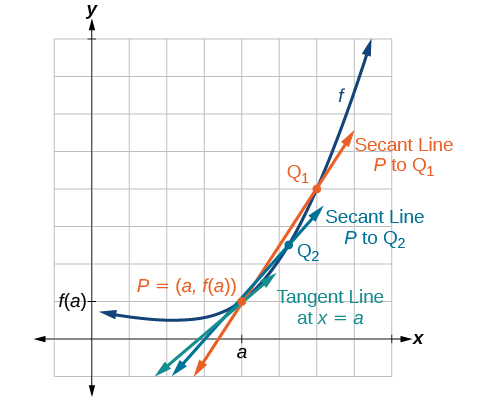| << Chapter < Page | Chapter >> Page > |
Find the average rate of change connecting the points and
We know the average rate of change connecting two points may be given by
If one point is or then
The value is the displacement from to which equals
For the other point, is the y -coordinate at which is or so
Now that we can find the average rate of change, suppose we make in [link] smaller and smaller. Then will approach as gets smaller, getting closer and closer to 0. Likewise, the second point will approach the first point, As a consequence, the connecting line between the two points, called the secant line, will get closer and closer to being a tangent to the function at and the slope of the secant line will get closer and closer to the slope of the tangent at See [link] .

Because we are looking for the slope of the tangent at we can think of the measure of the slope of the curve of a function at a given point as the rate of change at a particular instant. We call this slope the instantaneous rate of change , or the derivative of the function at Both can be found by finding the limit of the slope of a line connecting the point at with a second point infinitesimally close along the curve. For a function both the instantaneous rate of change of the function and the derivative of the function at are written as and we can define them as a two-sided limit that has the same value whether approached from the left or the right.
The expression by which the limit is found is known as the difference quotient .
The derivative , or instantaneous rate of change , of a function at is given by
The expression is called the difference quotient.
We use the difference quotient to evaluate the limit of the rate of change of the function as approaches 0.
The derivative of a function can be interpreted in different ways. It can be observed as the behavior of a graph of the function or calculated as a numerical rate of change of the function.

Notification Switch
Would you like to follow the 'Precalculus' conversation and receive update notifications?